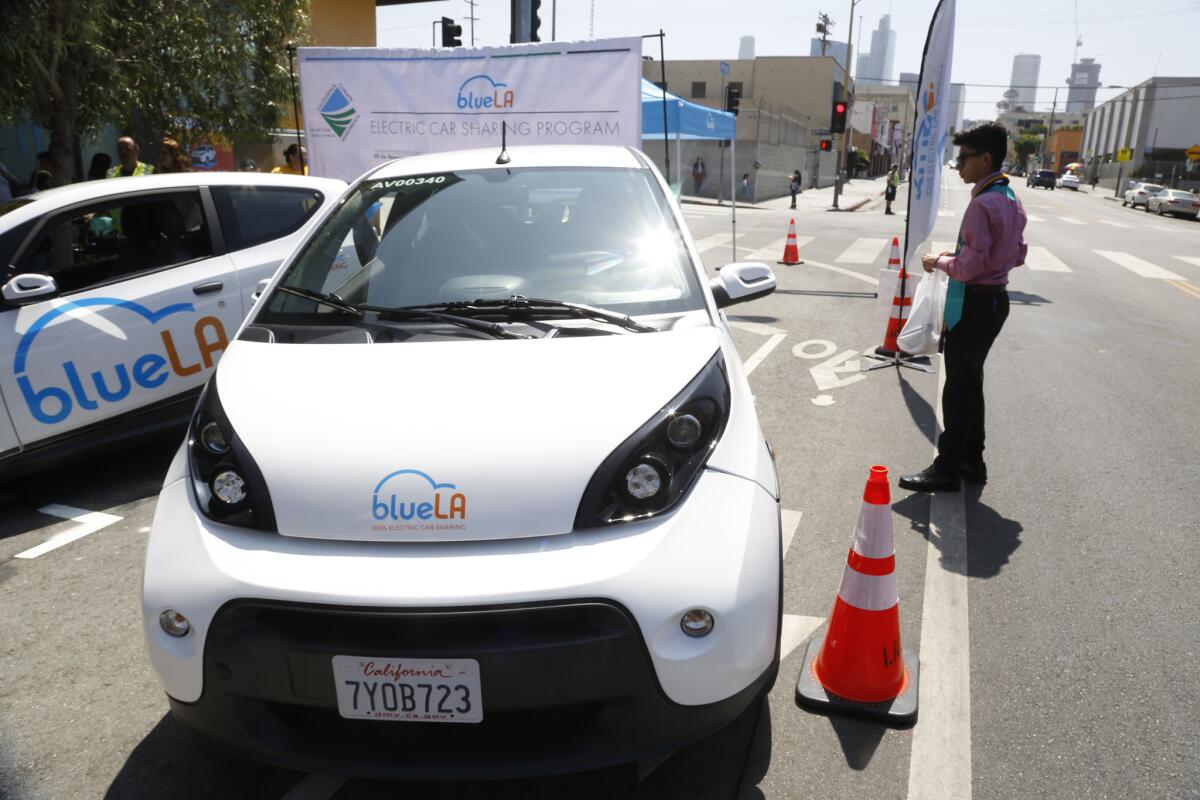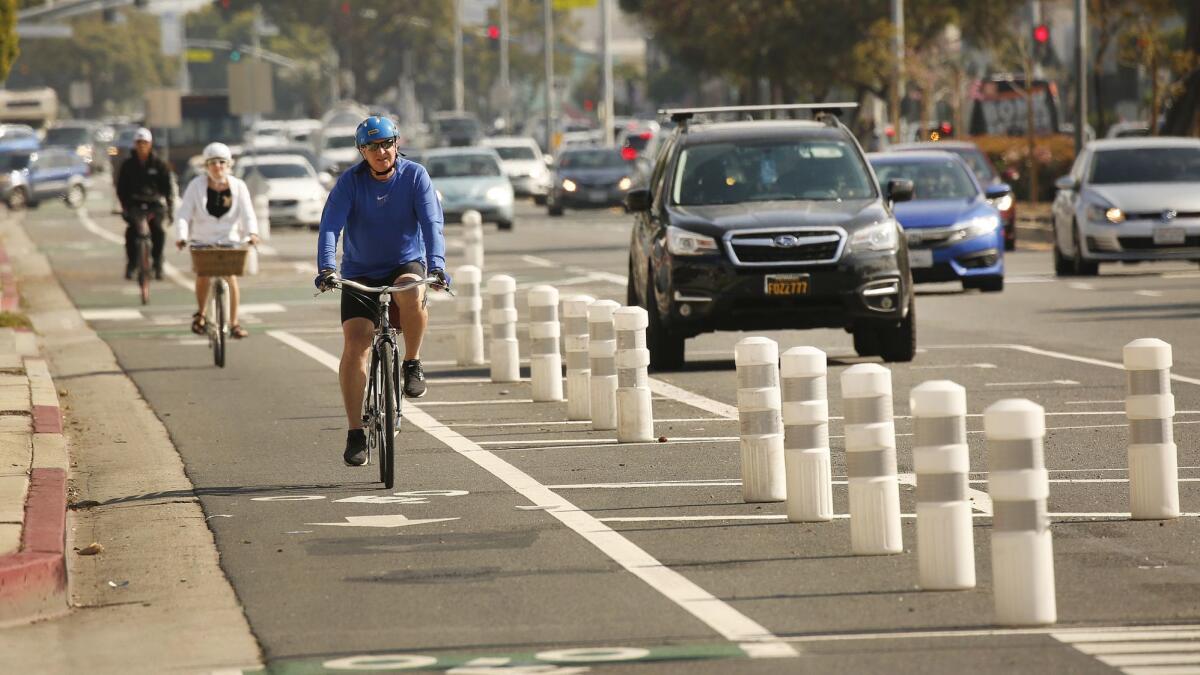Cities, states and companies vow to meet U.S. climate goals without Trump. Can they?

- Share via
Despite President Trump‘s decision to withdraw from the Paris climate accord, the United States hasn’t completely abandoned the landmark international agreement.
In fact, when the president announced his intent to drop out of the deal two years ago, he inadvertently catalyzed a flurry of climate action among cities, states, businesses and other organizations that remain committed to reducing carbon emissions in order to help the world avoid the worst effects of global warming, experts said.
For the record:
10:11 a.m. Nov. 6, 2019An earlier version of this story said 17 states and territories were members of the U.S. Climate Alliance. As of this year, that number has risen to 25.
“That was already going on, but the Trump administration really put that on steroids,” said David Victor, a climate policy researcher at UC San Diego.
More than 400 city leaders have joined the Climate Mayors association, and 25 states and territories have joined the U.S. Climate Alliance. Both organizations have vowed to uphold the country’s Paris pledge.
Many city, county, state and tribal governments have also signed the We’re Still In declaration, which reiterates support for the accord. So have 2,200 businesses and investors, 350 universities and 200 faith groups.
Together, these players account for almost 60% of the U.S. economy, half the country’s population, and 37% of its greenhouse gas emissions, according to an assessment by America’s Pledge, an initiative focused on sub-national climate actions led by former California Gov. Jerry Brown and ex-New York City Mayor Michael Bloomberg.
If this collection of governments and organizations were their own country, they would be the world’s third-largest emitter.
But how much can they do to fight climate change in the absence of federal leadership?
Quite a lot, said Carla Frisch, a researcher at the Rocky Mountain Institute who has helped write reports for America’s Pledge.
“If you take all those small pieces and add them up,” she said, “it is really significant.”
In a 2018 analysis, Frisch and her colleagues found that existing commitments by sub-national actors could achieve two-thirds of the emissions reductions called for in the U.S.’s Paris pledge. Broader participation and additional measures, like rapid retirement of coal-fired power plants, could bring that number close to 90%.
Under Obama, the U.S. had promised to get emissions 26% to 28% below 2005 levels by 2025. The country is already almost halfway there, although emissions rose in 2018 for the first time in three years.
To tackle the other half, all eyes are now on cities, states and businesses.
Cities are often touted as climate leaders, and many have set aggressive climate goals in recent years. Several have committed to getting all of their energy from renewable sources — a target Los Angeles aims to achieve by 2050.

Others have tried to green their streets by expanding public transportation and bike lanes. The Climate Mayors group is making bulk purchases of electric vehicles for city fleets.
Many communities are also passing ordinances to improve the energy efficiency of buildings and to meet heating, cooling and cooking needs with clean electricity instead of fossil fuels. In July, Berkeley became the first U.S. city to ban natural gas in new construction.
Together, concerted climate action across all U.S. cities could achieve 36% of the emissions reductions needed to fulfill the country’s Paris pledge, according to an analysis by the C40 Cities Climate Leadership Group.
However, because of their size and limited jurisdiction, cities have only so much power, said Leah Stokes, who studies climate and energy policy at UC Santa Barbara. “They have fewer tools in their toolbox to reduce emissions.”
She puts more stock in the states. To date, 37 states and four territories have adopted some kind of renewable energy target, a strategy that has been very effective at driving down emissions.
“Those policies have been really transformational,” Stokes said.
California’s pledge to provide 100% renewable energy by 2045 is one of the most ambitious. New York recently upped the ante with a law that requires it to source only clean energy by 2040, and for the state to achieve “net zero” greenhouse emissions by 2050.
States can provide incentives for purchasing electric vehicles and expand charging networks. And they have wide authority to promote climate action across communities and industries, such as by setting strict building codes and establishing carbon prices through measures like California’s cap-and-trade program.
According to the U.S. Climate Alliance, member states have already reduced emissions by 14% relative to 2005 levels.
Businesses have their own role to play, said Jessika Trancik, an energy systems researcher at MIT. More than 1,000 have joined the We Mean Business coalition, which advocates for a carbon-free economy. Companies can work toward that goal by purchasing renewable power, cleaning up their supply chains, and creating innovative technologies to reduce emissions.
Still, many agree that such efforts are no substitute for a national climate policy.
For one thing, it remains to be seen how many of these commitments will become reality.
“We’re still in the talking phase, in most cases,” said Victor, who lamented the lack of rigorous accountability for many sub-national climate efforts, which are mostly voluntary.
“Symbolically, it is really, really popular to be announcing things about climate change,” he said. “But the real work of solving the problem is very detailed infrastructure kinds of activity, and that’s much, much harder.”
And it will take even more aggressive cuts to meet the Paris accord’s goal of limiting warming to well below 2 degrees Celsius (about 3.6 degrees Fahrenheit) compared with pre-industrial temperatures. At the moment, most countries’ current pledges — including the one made by the U.S. — are too weak to deliver that outcome.
Federal action could help on many fronts, experts say. For instance, there are logistical challenges that the national government is best suited to tackle, like building new kinds of infrastructure to distribute and store clean-burning hydrogen fuel.
Expanding the use of renewables also will require moving electricity over long distances on the grid, including across state lines, which the federal government could coordinate, Victor said.
And until the government sets a baseline for climate action, there will be plenty of laggards, Stokes said.
“Even though we have some really great leaders in this country, like California, the downside of not doing it at the federal level means that you have many places that are not acting fast enough,” she said. For instance, she noted, most Southern states have not adopted renewable energy targets.
Ultimately, dealing with climate change is going to require a lot of money (although less than not dealing with it), and some will have to come from federal coffers, Stokes said.
Cities and states already need help financing their climate goals and managing the growing risks of climate-fueled disasters like wildfires and floods. And many agree on the need to dramatically increase funding to develop new energy technologies that will transform society.
In the past, such investments helped make renewable energy sources like solar power some of the cheapest on the market. Now it’s needed to advance things like greener planes and aviation fuels, Trancik said.
For her, the problem boils down to the lack of a strong “national narrative” that would help the country reduce emissions in ways that also spark innovation and economic opportunity.
“It’s not really allowing us to tap into the creativity and the strength of many people around the country who would like to do something about this problem,” she said.
At the moment, there is not just a leadership void at the federal level, but a concerted effort to block state actions that would reduce emissions, Victor said. For instance, Washington is now challenging California’s authority to set stringent fuel economy standards for cars and trucks.
The Trump administration has also rolled back Obama-era policies aimed at reducing greenhouse emissions, like the Clean Power Plan. One study found that its replacement, the Affordable Clean Energy Rule, could increase emissions and air pollution in many states.
Even so, everyone agrees that climate efforts by cities, states and businesses are important — and will be necessary regardless of what happens at the national level.
And momentum is only growing, Frisch said: “I think of it as a wave that’s been building and is crashing on us now.”







